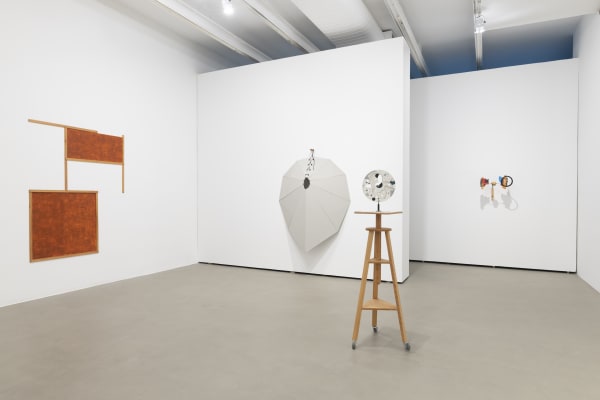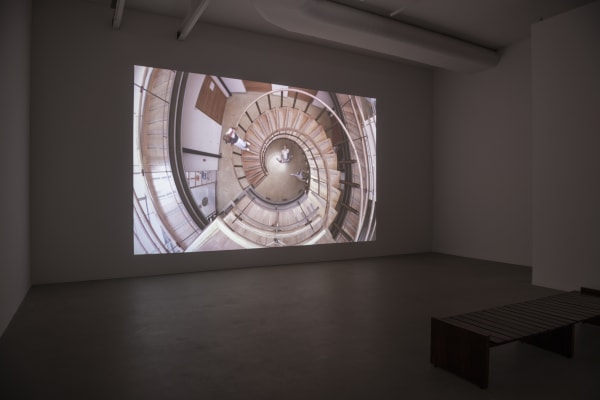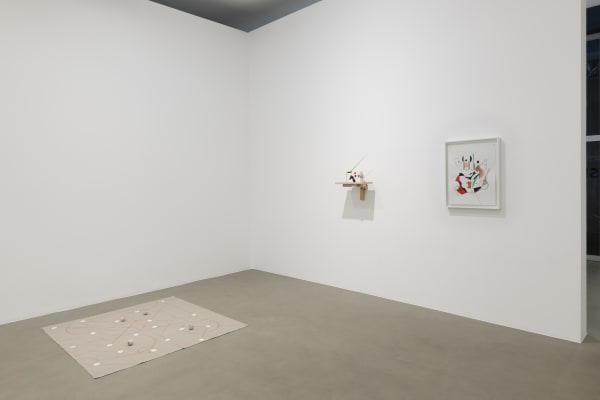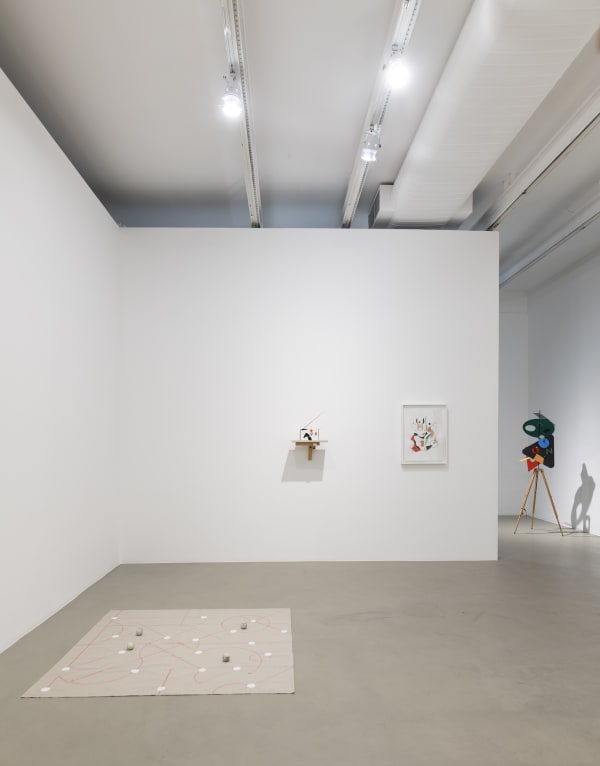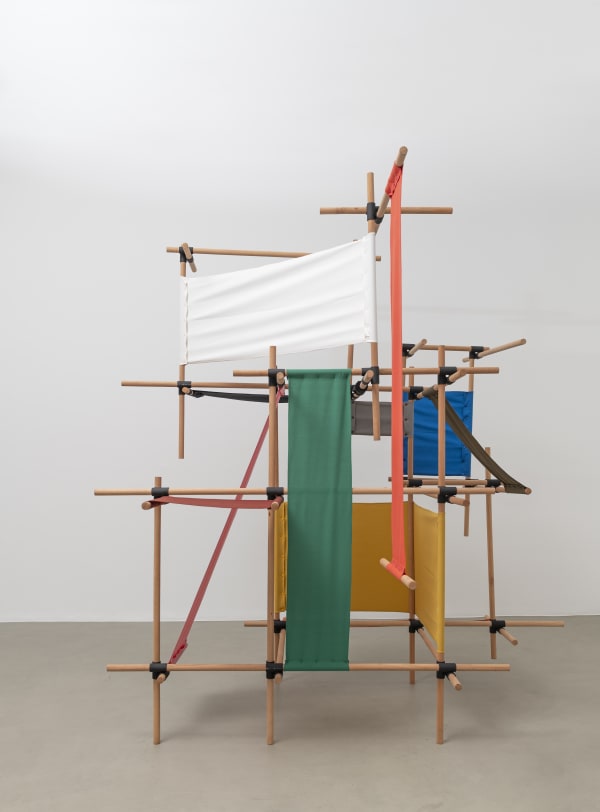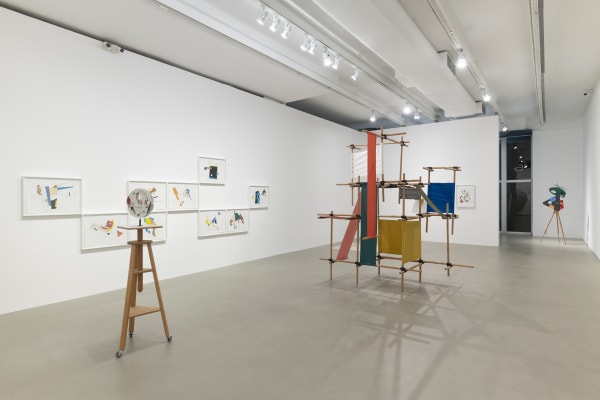Hesitante: Mateo Lopez
Galeria Luisa Strina is pleased to announce the third solo exhibition by Mateo López, Hesitante, from June 29 to August 21, 2021, in which the Colombian artist exhibits ten works in different media: drawing, video, sculpture, and installation. These are works that explore the idea of play, movement and activation of the exhibition space.
Following his inventive research on the spatialization of drawing, López extrapolates to the exhibition space different systems of lines and grids: in Palenquera (2021), for example, a modular structure similar to a scaffolding, but produced by hand with wood, suggests a body in movement, with monochromatic cotton fabrics serving as garments for this abstracted body. The inspiration for the work comes from fruit sellers on the streets of Cartagena, known as “palenqueras”. The term has its origins in San Basilio de Palenque, Department of Bolivar, near the Caribbean coast of Colombia, where the settlement was formed in the 18th century, one of the oldest quilombos in the Americas. The women of this community carried fruit collected in the crops in baskets upon their heads to sell in the city, ensuring their livelihood this way. Nowadays, the “palenqueras” of Cartagena, who wear colorful clothes and carry the fruit for sale in bowls on their heads, constitute an intangible cultural heritage like the Bahian acarajé sellers in Salvador.
Other works in the exhibition are an invitation to be activated by the viewer, such as Caja de Pinturas, Staccato, Bosque Paralelo, Monstera, Si Pero No. Although in the current context this idea of participation and interaction with others seems impossible, these pieces may continue persisting in provoking and making us think about our relationship with art in a more horizontal, playful, and less hierarchical way.
Some of the works originate from autobiographical anecdotes and his personal relationship with the history of art. An example is the series entitled Caja de Pintura, which carries a genesis of affective sphere, as the work’s design is originally inspired by a box of painting materials passed on by Mateo’s uncle, when he learned that he would study visual arts. Also modular, these works are made with binding boards layered with vinyl paint. The modular panels run through delicate grooves made in the box, generating intervals and internal spaces that allow the eyes to wander around the interior of the painting, as happens, for example, in the enjoyment of the works of Donald Judd.
Minimalism is a reference for López, who prefers, however, to oppose the monumentality of the North American movement with the more human scale of objects created by Brazilian concretism and neo-concretism. A tribute to the latter is in the work Monstera (2021), a foldable and manipulable abstraction of the Monstera Deliciosa plant from Araceae family, which grows in the courtyard of the artist’s house in Bogotá, and that the visitor could wear like a parangolé, or inhabit like Lygia Clark’s Poetic Shelter.
At the end of the room, at the back, is the exhibition’s centerpiece, Corpos Disobedientes (2020-2021), an audiovisual projection that reinforces the aspect of human resilience in the midst of sanitary and political crises. The video is a documentation of a work commissioned by the Museo Banco de la Republica, filmed in collaboration with three dancers, Lobadys Perez, Ana Contreras, and Melissa Alvarez, in halls inside the museum in Bogotá. There, according to the artist, it was shocking to see the huge public library empty, with the newspapers of March 17, 2020 intact on the table. That Tuesday, the 17th, was the day the lockdown began in the city of López, four days after our fateful Friday, the 13th, in São Paulo. Upon receiving authorization to carry out the project of the videos in shut down spaces, intending a solo exhibition scheduled for July this year, Mateo López says that the proposed occupation of spaces by the bodies of dancers gained more strength, given the state of suspension in which he found corridors, amphitheater, auditorium, library, and exhibition rooms during a technical visit to the closed museum due to the pandemic.
In the artist’s words: “the title, Cuerpos Disobedientes, came to my mind performing the activations in space. And it was specifically in the auditorium of the Luis Ángel Arango Library where Melissa -one of the dancers- moved over the chairs of the auditorium in a very anarchic manner and contrary to the norms of behavior in public spaces of specific use that “the disobedient body” occurred me and I believe that when everyone sees it, we feel this freedom. My work is precise, meticulous and over time I learned to deal with chaos, to make something out of chaos at a time when we were made to believe that everything is under control.”

